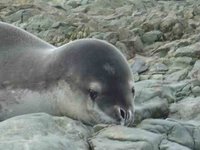November 24: Revisiting the penguins
 Surface ice on Marion Bay
Surface ice on Marion BayNovember 24, 2006
On board the RV Yuzhmorgeologiya
Marion Bay, King George Island, Antarctica
It was difficult to believe we are actually in Antarctica. We are anchored in Marion Bay directly off shore from the Korean base. If it wasn’t for the thin layer of surface ice, the calm blue seas could have been found in the tropics. The wind conditions were calm and skies clear for the entire day.
The first order of business was to offload the supplies and personnel from the RV Yuzhmorgeologiya for the King Sejong Station, Korean’s base on King George Island. After donning Mustang suits for protection against the elements, our entire team climbed down the rope ladder into a Zodiac for the short journey to the Station.
Haru, Bob and I were here last year, but this was a new experience for the rest of the team. After checking in with the base commander, we hurried up the shore to the penguin rookery. We encountered a Weddell seal on the way. She was stretched out, utterly relaxed, and only opened her eyes as we approached. Since seals have no terrestrial predators in the Antarctic, she simply went back to sleep as we moved on.
 Nesting Gentoo penguins
Nesting Gentoo penguinsAs we drew nearer to the rookery, its telltale odor greeted us. Moving up a snowy slope, small groups of Gentoo penguins alternately waddled and rested as they made their way. The wind was much stronger last year, masking the Gentoos’ soft calls. Their cooing and crackling were easily distinguished as we approached. The rookery is extensive; their stony nests are clustered is several areas. Most of the penguins were lying prone on their nests, keeping the eggs warm. Scattered individuals were moving about the colony. Most were either returning to sea to feed, or back to their nest to relieve their mate. However, I watched one penguin roaming about the colony, selecting individual stones and returning each to his/her nest where its mate was incubating their egg.
 Leopard seal
Leopard sealThe penguin rookery was fascinating, but more surprises waited for us down the shoreline. I was exploring the tide pools, finding limpets and algae, but little else, when I glanced up to see a motionless shape on the beach. At first I thought it might be a dead Weddell seal, but upon closer examination I saw its chest slowly rising and falling. Even more exciting, its elongated neck and head revealed it to be a young leopard seal. As I called out to the others, it awoke but didn’t stir. With every breath, milky-white mucus drained out its nostrils. As the others approached, the leopard seal warily raised its head. I was careful not to get between the seal and the water, fearful that it might charge if it felt threatened. I shouldn’t have worried though. As we passed, the leopard seal began to move across the stony beach with a labored, undulating gait. Moving so slowly, I think the penguins could out run it on land.
 Elephant seal
Elephant sealA final surprise waited. The distinctive exhalation of a marine mammal caused me to scan the horizon for a whale. But I was looking in the wrong direction. I spun around after the next exhalation and was surprised to see an elephant seal on the beach no more than twenty feet away. With its large eyes, it was following my every move. It was time for us to return to the ship, but these memories will follow me forever.
 The research team en route to the penguin colony near near King Sejong Station
The research team en route to the penguin colony near near King Sejong Station



0 Comments:
Post a Comment
<< Home